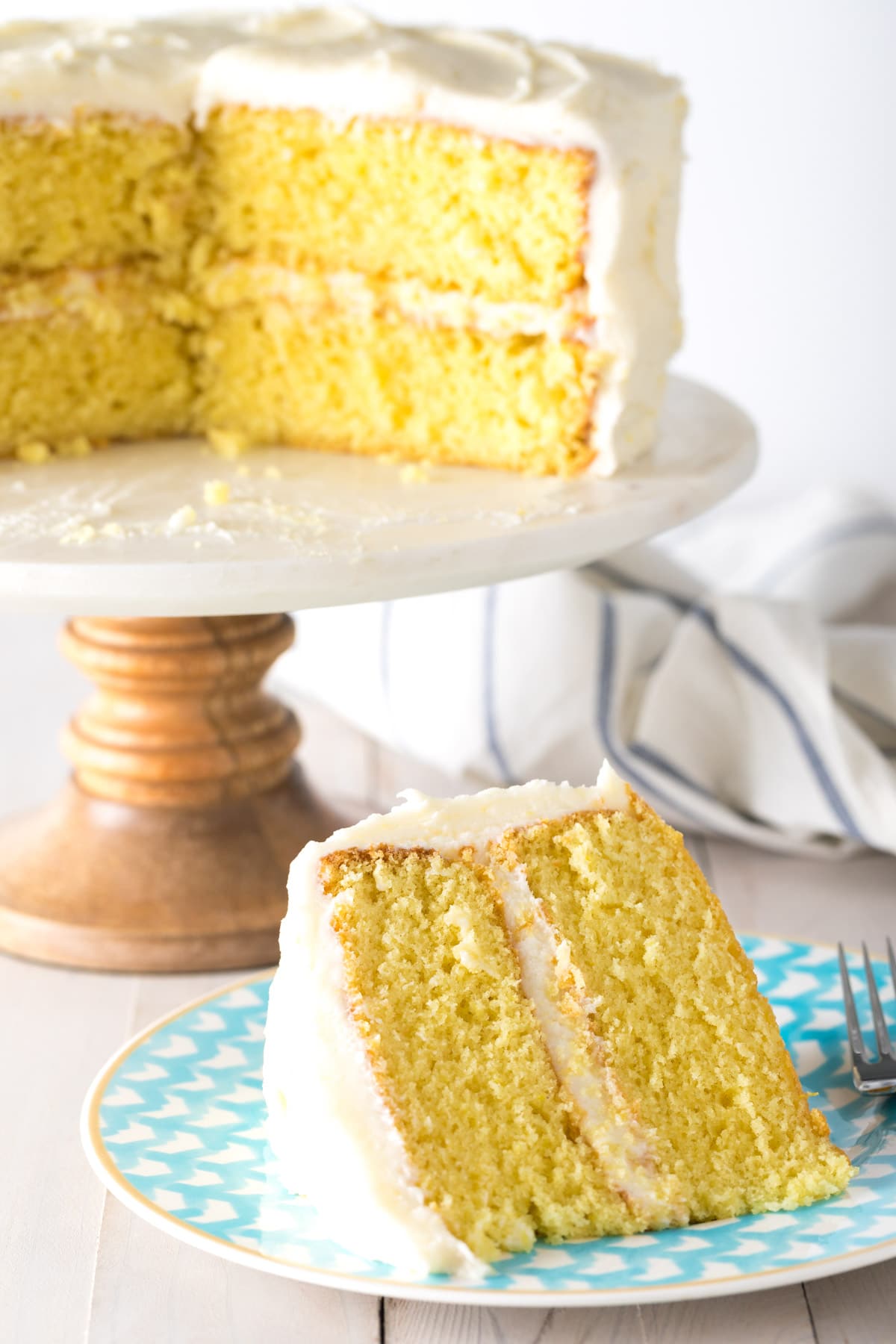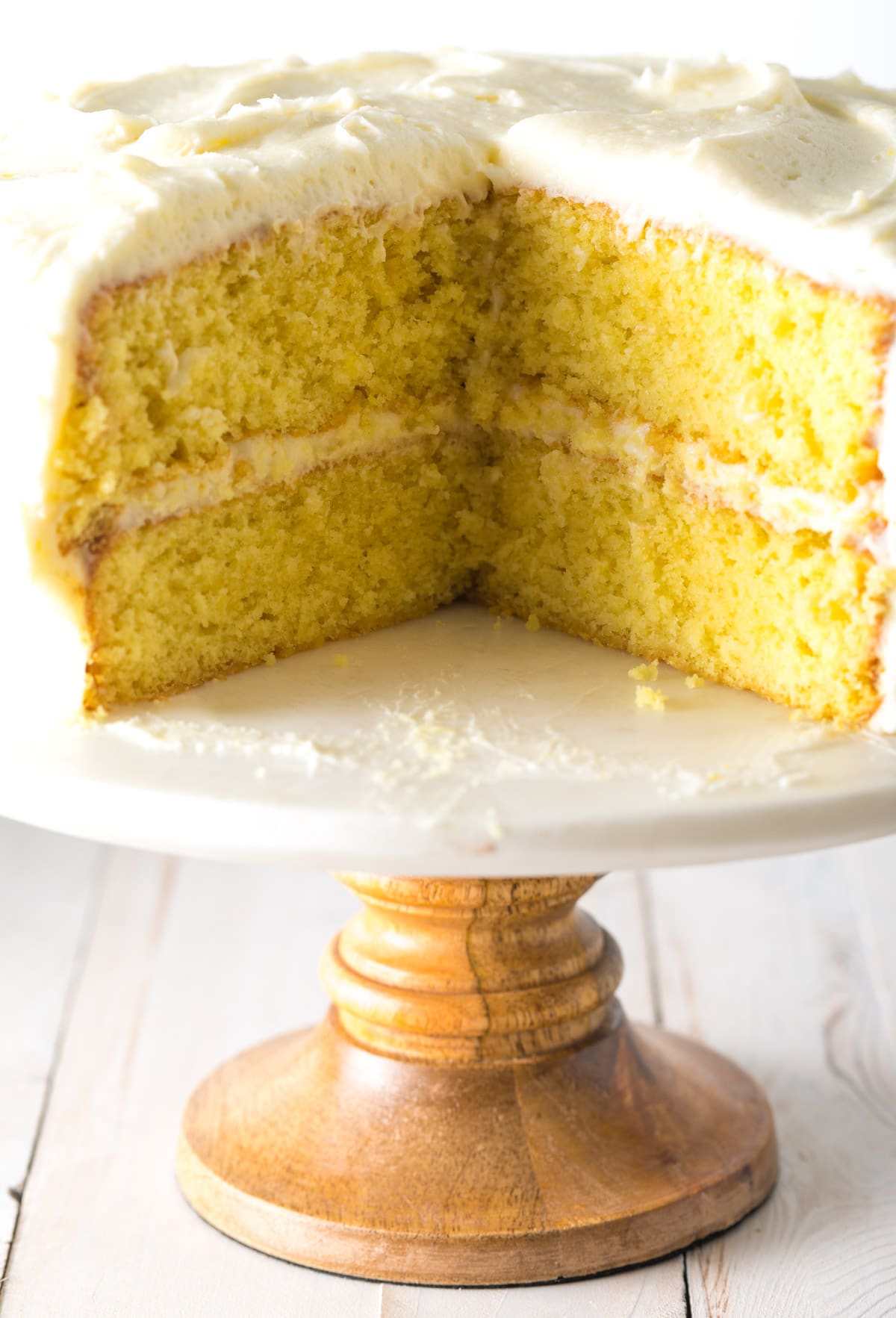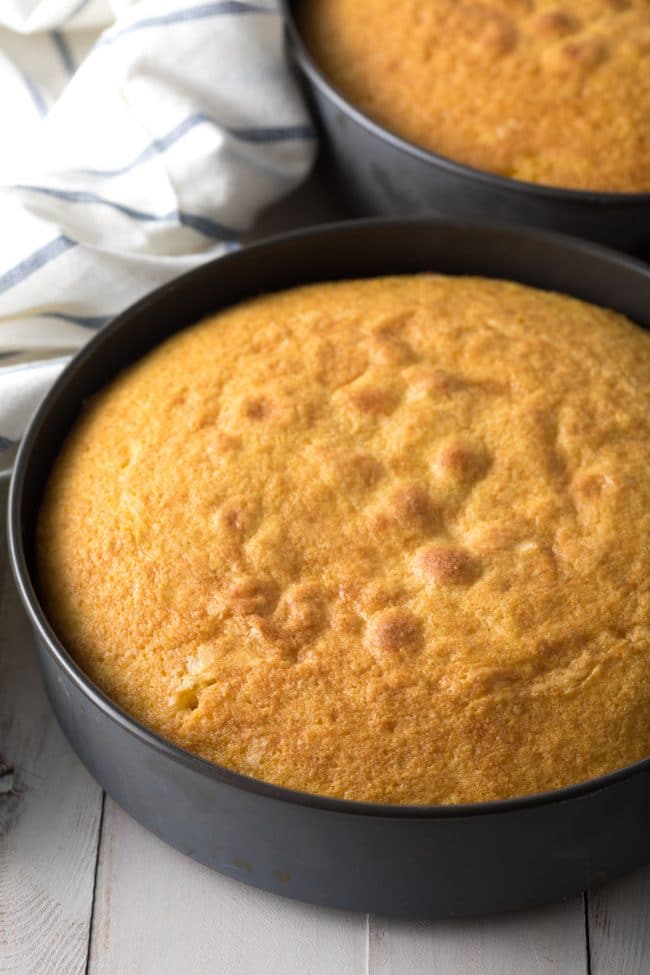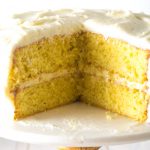Best Lemon Buttermilk Cake
Lemon Buttermilk Cake Recipe – This simple southern lemon layer cake is soft and moist with a tangy buttermilk frosting. It’s a tender, sweet cake that is sure to become a family favorite!

Why We Love This Lemon Buttermilk Cake Recipe
When I first moved to the south, I did not realize there is a difference between a southern cake… And all other cakes.
In fact, I might go as far as to say I never truly had a mind-blowing cake until I moved to North Carolina.
For those of you living anywhere else in the country (or world) a southern cake has nothing to do with the style or flavor of the cake. Instead, it has everything to do with the overall texture, moistness, and sweetness.
I have eaten more than my fair share of cakes in my lifetime, and this one checks off all the boxes, plus some!
- It is super soft and light with a fine, delicate crumb. It’s the kind you have to be careful about flipping out of the pan so that it doesn’t fall apart.
- It is very moist and tender due to the addition of buttermilk. There is nothing “bready” about a southern cake. If you press down on a piece with your fingers, you can almost squeeze out the butter or oil. Plus, the moisture in the frosting prevents the cake layers from drying out.
- It is, in fact, sugary-sweet. Although I tend to like desserts to be not too sweet, I make an exception when it comes to cake. The best cakes I’ve ever eaten have been powerfully sweet. However, the lemon flavor balances the sweetness, so it doesn’t come off as being too overpowering.
Speaking of the lemon flavor, it is derived from three places… Lemon zest, lemon juice, and lemon extract. Therefore, it offers both a bright, fresh lemon flavor and a deeper underlying lemon essence.

Ingredients You Need
For the cake –
- Cake flour – or 2 ½ cups all-purpose flour + ¼ cup cornstarch
- Baking powder – for the most soft and fluff cake
- Baking soda
- Salt – brings out the flavor of the cake
- Sugar
- Unsalted butter – softened to room temperature
- Eggs – room temperature
- Vegetable oil
- Lemon zest and juice – use fresh zest and juice
- Vanilla extract – use high-quality real vanilla extract
- Lemon extract
- Food coloring – optional, but brings out the natural yellow color of the lemon
- Buttermilk – or 1 cup buttermilk = 1 tablespoon of vinegar and enough milk added to equal 1 cup
For the Frosting –
- Butter
- Buttermilk
- Lemon juice
- Powdered sugar
How to Make This Lemon Cake Recipe
- Preheat your oven to 350°F. Grease and flour two 9-inch round cake pans.
- Using an electric stand mixer, beat the butter and sugar together until light and fluffy. (This should take about 3-5 minutes on high speed.)
- Combine the cake flour, baking powder, baking soda, and salt in a separate bowl.
- After creaming the butter and sugar, scrape down the sides of the bowl with a rubber spatula. Then, with the mixer on low speed, add the eggs, oil, lemon zest, vanilla extract, lemon extract, and yellow food coloring.
- Scrape down the sides of the bowl again. Reduce the mixer speed to low and gradually add the flour mixture and buttermilk, alternating between the two until they are fully combined. As soon as the batter is smooth, stop the mixer.
- Divide the batter evenly between the two prepared pans. Bake in the preheated oven on the middle rack for 30 minutes without opening the door.
- If the cakes are puffed up in the center, test them for doneness by inserting a toothpick into the center. If the toothpick comes out clean, the cakes are done. If there is batter on the toothpick, bake for another 5-10 minutes and check again.
- Let the cakes cool in the pans for 10 minutes. Then, carefully invert them onto cooling racks. Remove the parchment paper and let the cakes cool completely.


- When the cakes are cool, place the butter in a clean stand mixer bowl. Beat the butter until it’s fluffy. Scrape down the sides of the bowl and turn the mixer to low speed. Add the buttermilk and lemon juice, followed by the powdered sugar one cup at a time. Beat until everything is well combined.
- Once you’ve added 5 cups of powdered sugar, increase the mixer speed to beat out any clumps. Check the consistency of the frosting. If it’s too thin, add another 1-2 cups of powdered sugar and beat until the frosting is smooth.
- Place one cake on a cake stand or platter. Scoop approximately 2 cups of frosting onto the cake. Use a large offset spatula to spread the frosting evenly over the top of the cake.
- Place the second cake on top of the frosted layer, ensuring it’s centered. Gently press down on the top layer to level it. Then, add the remaining frosting to the top of the cake. Use the spatula to spread the frosting over the top and down the sides of the cake.
- Turn the cake stand to smooth out the sides of the cake with the flat edge of the spatula. When you’re satisfied with the sides, use the spatula to create swooping marks on the top of the cake. Wipe the cake stand clean with a wet paper towel.
- Cover the cake and keep it at room temperature for up to 4 days. If you prefer, you can refrigerate it for up to a week. However, for the best flavor, let the cake warm up to room temperature before serving.
Get the Full (Printable) Best Lemon Buttermilk Cake Recipe Below!


Recipe Variations
- Raspberry swirl – For a burst of fruity flavor, fold in a cup of fresh or frozen raspberries into half of the batter. Layer the raspberry batter and plain batter in the prepared pans.
- Lavender lemon: Add a touch of floral notes by incorporating a teaspoon of dried lavender into the cake batter.
- Coconut flakes – For a tropical touch, fold in a cup of shredded coconut.
- Lemon curd filling: Fill the layers of the cake with lemon curd for a burst of tartness.

Recipe Tips and Tricks
- Prep your pans. Make sure to grease your pans and add a circle of parchment paper to the bottom of each pan. This will guarantee the cakes come out in one piece.
- Cream the butter and sugar long enough. This is a step rookie bakers often skip. When you beat softened butter and sugar together at high speed, it fluffs the butter for a light, airy cake texture and breaks down the sugar crystals. To do this properly, it usually takes a full 3-5 minutes. If you skip this step, your cake will be dense instead of pillowy.
- Measure properly. Think of cooking as an art and baking as a science. If you are heavy-handed with your measuring or don’t add enough of an ingredient, the chemical reaction in your oven will be different than mine. Be exact. And don’t forget to sift, or at least stir, your flour before measuring.
- Scrape the bowl. Use a rubber spatula to scrape the mixing bowl between steps so all the ingredients are incorporated evenly.
- Don’t overbeat the batter. It’s easy to turn on the mixer and then go about doing other things, forgetting about the batter. However, cake batter can be overmixed! This leads to a tough texture or even a cake that sinks in the middle. Mix the batter until smooth. Once all the ingredients are incorporated… TURN THE MIXER OFF.
- Don’t disturb the baking cake. Leave it alone, guys! Don’t open the oven door fifteen times while it’s baking. I would even suggest you walk lightly through your kitchen while the cake is baking. It needs consistent heat and no movement to rise properly. Opening the oven door and banging around the kitchen can cause your cake to collapse in the center before it’s fully baked. If you can be patient, you will be thrilled with the results.
- Cool completely. Don’t rush the cake frosting. Make sure to give your cake ample time to cool. Even a little warmth will make the frosting slump down the sides as you try to smooth it.
I’ve also included pro frosting tips to make this the easiest and most beautiful cake you’ve ever baked!
Learn How To Make Buttermilk Here.
If you are new to baking, check out our 100 Best Baking Tips Tutorial.

Frequently Asked Questions
How well does this cake keep?
You can let it sit out for 3 days at room temperature, or it will last 7-10 days in the refrigerator. Make sure to wrap it well.
Can I freeze this cake?
Wrap the cake well with a layer of plastic wrap, then foil. Freeze for up to 6 months. Then thaw at room temperature.
To preserve the best possible appearance on the outside, you can “flash freeze” the cake, unwrapped, for about an hour so the frosting hardens. Then wrap well and freeze.
What if I want to make these into cupcakes
For cupcakes, I would increase the heat to 375 (for a higher dome) and bake for about 15-18 minutes. This recipe would make about 18-24 cupcakes.
Can I make this in a 9×13 pan?
Yes, you can! Bake it at 350 for 30-35 minutes.
Can I add poppy seeds?
You sure could! I would start by adding 1 tablespoon of poppyseed to the batter and then add more as needed.
My cake came out spongy and rubbery. Any idea what I may have done wrong?
It sounds like you might have overmixed the cake batter. It’s important to stop mixing the batter once the ingredients are fully combined.

Looking for More Classic Southern Desserts? Be Sure to Try:
- Strawberry Yogurt Bundt Cake
- Perfect Carrot Cake
- Chocolate Cupcakes with Strawberry Frosting
- Hummingbird Cupcakes
- Chocolate Mint Texas Sheet Cake
- Vegan Chocolate Chia Seed Pudding Recipe
- Fluffy Divinity Candy Recipe
- Scottish Shortbread (Easy Shortbread Cookie Recipe)
- The Easiest Candied Orange Peel Recipe
- Linzer Cookies (Cut Out Cookies Recipe)
Get the Full (Printable) Best Lemon Buttermilk Cake Recipe Below!
Best Lemon Buttermilk Cake Recipe
Ingredients
For the Cake –
- 2 ¾ cups cake flour, sifted (or 2 ½ cups all-purpose flour + ¼ cup cornstarch)
- 2 teaspoon baking powder
- ¼ teaspoon baking soda
- 1 teaspoon salt
- 2 cups granulated sugar
- 10 tablespoons unsalted butter, softened
- 4 large eggs
- ¼ cup vegetable oil
- Zest of 1 lemon (save juice for frosting)
- 1 tablespoon vanilla extract
- 1 teaspoon lemon extract
- 3-5 drops yellow food coloring *optional
- 1 ¼ cup whole-fat buttermilk
For the Frosting –
- 1 ½ cups unsalted butter, softened (3 sticks)
- 3 tablespoons buttermilk
- 1 ½ tablespoons lemon juice
- 5-7 cups powdered sugar
Instructions
- Preheat the oven to 350 degrees F. Spray or grease two 9-inch round cake pans. Cut out 9-inch parchment paper circles, and press down in the bottom of each pan. (Trace the pan for perfect circles.)
- For the Cake: In the bowl on an electric stand mixer, cream the butter and sugar together until light and fluffy. (Cream: Beat on high approximately 3-5 minutes to break down the sugar crystals.)
- In a separate bowl, mix the cake flour, baking powder, baking soda, and salt.
- Once the butter and sugar are well creamed. Scrape the mixing bowl with a rubber spatula. Then turn the mixer on low and beat in the eggs, oil, lemon zest, vanilla extract, lemon extract, and yellow food coloring.
- Scrape the bowl again. Turn the mixer back on low and alternate adding the flour mixture and buttermilk until both are well combined. Once the batter is smooth, turn the mixer off immediately.
- Pour the batter evenly into the two prepared pans. Bake on the middle rack, undisturbed for 30 minutes.
- If the center of the cakes are puffed up, check the cake by inserting a toothpick into the center. If it comes out clean, take them out of the oven. If the toothpick has batter on it, bake another 5-10 minutes and recheck.
- Allow the cakes to cool 10 minutes in the pans. Then carefully flip them out on a cooling rack. Remove the parchment paper and cool completely.
- For the Frosting: Once the cakes are room temperature, place the butter in a clean stand mixer bowl. Beat until fluffy. Then scrape the bowl and turn on low. Mix in the buttermilk and lemon juice. Then add the powdered sugar one cup at a time, beating to incorporate.
- After adding 5 cups of powdered sugar, turn the mixer up to beat out any clumps. Check the consistency of the frosting. If it is too loose, add another 1-2 cups of powdered sugar and beat until smooth.
- To Assemble:Move one cake to a cake stand or platter. Scoop about 2 cups frosting onto the cake. Use a large flat spatula to spread the frosting out evenly.
- Set the second cake on top of the frosting, being careful to center the cake. Gently press the cake a little to level the top. Then scoop all remaining frosting on top of the cake. Use the spatula to work the frosting over the top and down the sides.
- Turn the cake stand to smooth out the sides with the flat edge of the spatula. Once you are satisfied with the sides, use the spatula to make swooping marks on the top of the cake. Use a wet paper towel to clean up the cake stand.
- Cover and keep at room temperature for up to 4 days, or refrigerate for up to a week. When ready to serve, make sure the cake is at room temperature… All classic layer cakes taste best at room temperature!
Video
Notes
- Spread a thin “crumb coat” layer of frosting over the cake to catch and seal in the crumbs. Then spread on the final “pretty” layer of frosting on top.
- Or you can wrap the cakes in separate pieces of plastic and freeze them. Then a few hours later, you can unwrap, level, and frost the cake with a lot of added stability. Just be sure to do this at least 6 hours before serving so the cake layers have time to thaw.



This is the best lemon cake I have found!! Its very delicious!!!!!
I totally recommend it! 😀
Can this recipe be used to make cupcakes?
Hi Marisa,
Sure, you can! For cupcakes, increase the heat to 375 (for a higher dome) and bake for about 15-18 minutes. This recipe should make about 18-24 cupcakes.